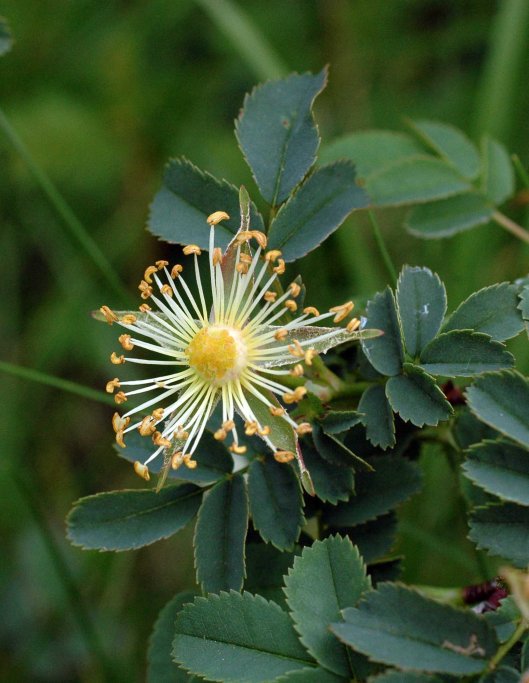Family: Rosaceae Other English name: Pimpinell Rose Welsh name: Rhosyn Dewi (Rhosyn y Twyni) Irish name: Briúlán
There is a glorious stretch of these lovely and very prickly roses on Bryn Euryn that are fully in flower now.
The Burnet Rose is a low-growing species, largely confined to dry sandy places near the sea; it is particularly abundant on dune systems in South Wales. Inland it may be found in calcareous areas, generally chalk downland or limestone pavement.
Its natural distribution is limited to Europe and Asia except for part of the Atlas Mountain Range in North Africa.
It is a rather low erect deciduous plant usually growing to 20–140 cm high but it can sometimes reach up to 2 metres.
The plant spreads by suckers and can cover large areas. The stems are protected by numerous stiff bristles and many sharp straight prickles. The young stems and prickles and the mature leaves tend to be very red with young growth a bright scarlet and older growth a deep maroon.
‘Some people are always grumbling because roses have thorns. I am thankful that thorns have roses’.
Alphonse Karr (1808-1890)
The flowers are cream-white although rarely also pale pink and are 2–4 cm in diameter with five petals. prominent golden stamens and they have the sweetest, most delicious scent of any of native roses.
Bumblebees seem to love them, perhaps because they do have a hint of honey in their scent.
Soon the petals fall off the roses but the stamens look pretty too. The leaves are small and oval, very like those of the salad burnet (hence the name).
And later in the year there will be a crop of distinctive globular dark purple to black hips.
A brilliant-orange rust fungus Phragmidium rosa-pimpinellifoliae is also common on the plants.
The plant’s names
R. spinosissima (pimpinellifolia) has been known by many different local names and it has attracted its own folklore. In some places, people have given it a vernacular name based on the resemblance of the leaves to a Burnet (Sanguisorba ) and therefore, for example, called it the Burnet or Pimpinell Rose in English or Rose Pimprenelle in French. In other places, it was the prickly stems that caused it to be known as Bodicasti Sipek in Slovenia, for example, or Piikkiruusu in Finland.
In Iceland, it has the name pyrinros which literally means ‘Thorny Rose’ but the same Icelandic word means ‘Sleeping Beauty’ and may refer to its early flowering – the beautiful rose waking up after the long dark Icelandic winter! In Norway, this rose is called ‘Trollnype’ – associating it with the trolls of Norwegian folklore. Elsewhere, it is named after the coastal sand-dunes where it grows so, for example, it is Klitrose in Denmark,Duinroos in The Netherlands or Dünen Rose in Germany.
Medicinal uses
(Extracts from: Rosa spinosissima – aspects of its natural history and associations with people from prehistory to the present day ) by









Pingback: Burnet Rose: Rosa Spinosissima – Dyfi Welsh Biosphere
Pingback: Beautiful blooms and some rare treats (1) | everyday nature trails